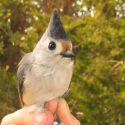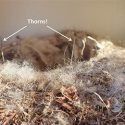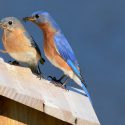 Photo ©
Keith Williams
Photo ©
Keith Williams

Hybrid Titmouse Nesting Success
Four years ago, we reported on a hybridization study undertaken by Ph.D. candidate Claire Curry. This month, we are happy to bring you a research update from Dr. Curry’s recently-published paper.
Where two closely-related species overlap in range, there is the potential for them to interbreed and form hybrids. Sometimes species hybridize (e.g., Black-capped and Carolina chickadees), but sometimes they don’t (e.g., American and Fish crows). Why? Claire and her colleagues set out to address this question using the Black-crested and Tufted titmouse hybrid zones in Texas and Oklahoma.
Using data from 195 nests submitted by NestWatchers in the Texas hybrid zone, Claire investigated whether there were any differences in nesting success of Black-crested, Tufted, or hybrid titmice. Hybrids of many species tend to have lower nesting success, but Claire found no differences in clutch size, brood size, or nesting success among the three types. This suggests that poor reproductive fitness is not the reason that Black-crested and Tufted titmice remain separate populations.
Claire’s research also investigated behavior, such as preference for song and plumage types, which show more promise in figuring out where these two distinct populations may diverge from each other. According to Claire, “The NestWatch data provided a useful view of the status of hybrid reproductive fitness. More data are needed from the Oklahoma hybrid zone, where the lack of NestWatchers makes understanding their nesting success in this area difficulty to study.”

A Bed of Thorns
When Frank Colver decided to relocate an old Say’s Phoebe nest from an unstable spot to a newly constructed nesting shelf, he jumped in pain and surprise when the nest pricked his bare hands.The exterior of the nest was lined with tiny, barbed spines from a Gander’s cholla cactus.
During the breeding season, cacti fulfill an important ecological role for desert-dwelling birds. Birds such as Gila Woodpeckers, Gilded Flickers, and Elf Owls create or utilize existing nest cavities, while other birds such as Harris’s Hawks build nesting platforms atop tall, sturdy cacti. Curve-billed Thrashers, Cactus Wrens, and Greater Roadrunners build their nests deep within a cactus’ thorny and protective embrace.
In most cases, birds place their nests in a cactus rather than collecting thorns for their nests. In fact, we believe that Frank’s discovery is not only odd for Say’s Phoebes, but it is also uncommon for birds across the U.S. While thrashers are also known to include thorny twigs in their nests, we haven’t seen any examples with cactus spines.
Frank’s discovery is a mystery. Did the phoebe select the barbed spines to help hold the nest together? Were the spines meant to create a protective fortress around the soft interior of the nest? Or were they just a convenient source of nest material? Moreover, have other NestWatchers discovered nests that had spines incorporated as nesting material? If you have discovered a literal bed of thorns, we would love to know. Share your photos or email NestWatch.

Cap Open Pipes To Save Birds
Researchers Chuck Hathcock and Jeanne Fair of the Los Alamos National Laboratory have uncovered a potential threat to birds that could be quietly hiding on your property. It turns out that open pipes or bollards, such as you might find supporting a gate, are often investigated by cavity-nesting birds. These birds may be attracted to the open pipes as potential nesting sites; however, after entering, the birds cannot escape.
Their analysis suggests that up to 27% of open pipes contained bird remains, mostly Western Bluebirds and other cavity-nesting birds. Larger pipes contained bigger birds such as jays and kestrels. Fortunately, the solution is simple. If you have open bollards or gate posts on your property, just cap them! Caps can be ordered to match the pipe’s material, or for an inexpensive fix, simply place a big rock, piece of wire mesh, or other homemade “cap” on top of the post. With all of the threats facing birds today, rarely is there a solution as simple and easy as this.
This video shows one lucky Western Bluebird being rescued from an open bollard that it had fallen into.

More Bulk Uploads
NestWatch continues to import bulk data. This month, we added 219 nest records from Leaser Lake in Lehigh County, Pennsylvania. Leaser Lake Heritage Foundation members John Higgins and Mike McCartney approached us with a data set that included Tree Swallows, Eastern Bluebirds, House Wrens, Wood Ducks, and American Kestrels, among others. The nest boxes were installed as part of the Foundation’s environmental education initiative to connect local youth with the lake. In addition to nest boxes, youth have built turtle loafing platforms, conducted stream and plankton studies, and restored the lake’s riparian zone.
Do you have an abundance of nest records? If you have >100 nest records (either historical or from this breeding season), please inquire about NestWatch’s Bulk Import Tool. We would love to add your records to our data set which currently includes over 311,000 nests! Contact us to find out more.